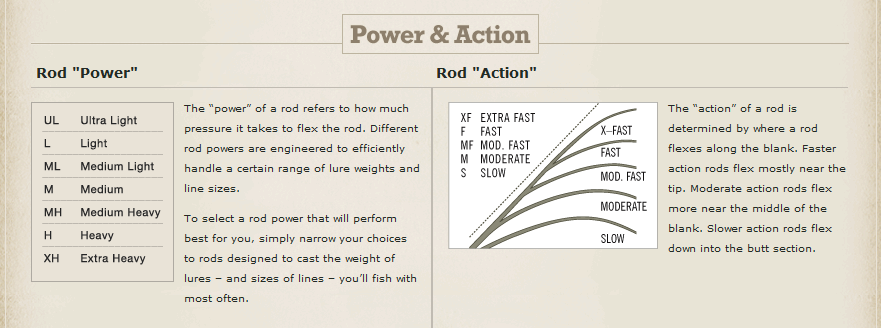When fishermen get together, the talk will sooner or later usually migrate to who has the best fishing pole, or who makes the top rated fishing pole or what fishing pole is the best one to use for a particular fish and so on.
“This pole is very flexible.” “This one has a lot of power.” “This one is very sensitive” and the conversation can go on for several six packs.

The truth is sometimes fishermen are saying the same thing but using different terminologies. All fishing poles have certain characteristics that have been built into them. They all have a certain amount of “POWER” and depending on how the pole has been wrapped at the tip end, will have a predetermined amount of “ACTION”.
So what does this mean? When it comes to how much power a fishing pole has, it is referring to how much energy it is required to bend the pole. The next question a person is going to ask himself is how do I use this information and make it useful to me and my situation.
Now, some of this is obvious. You do not need as much power to land a small blue gill as you do to bring in a large muscular catfish out of a river with a strong current on his side. No, to out man a big fighting catfish you need a powerful pole, or one that has a lot of backbone. A powerful pole is one that you can lean back into and the bend of the pole does not start clear down at the handle and is bowed all the way to the tip. A pole that curves along the whole length of the pole is considered parabolic. This type of pole would be a lesser strength pole, less backbone, than one that would not bend until you got further up the length of the pole, or one with more backbone. The further up the pole that it stays straight, before it begins to flex, would give the pole more muscle, or power.

Depending of what species of fish and the conditions will dictate which power of pole will be best to use.
The same thing is true of the action of the pole. The flexibility or bendability of the tip end is what gives the pole a different set of personality traits.
When you are casting your pole and the tip of the pole is behind you, the end is flexed and is loaded. The bent tip has stored energy that is ready to go into action. How much inertia is in the loaded tip of the pole along with the weight of your lure or bait will help determine how far you can cast.
Also the sensitivity of the pole is decided by the action of the pole. If the pole has a tip end that is soft or light, it has more tip flex that one that only bends right at the end or is fast. A fast tip action is very advantageous when you are try to set a hook when you are casting a long way out, but can be a determent for feeling very soft nibbles from a nervous fish.

Different poles for different applications and conditions and of course different kinds of fish.
No one fishing pole is going to serve all conditions and fish types. Having the understanding of what manufactures are trying to tell you with the labels on the fishing pole as you cruise the fishing tackle aisles will help you pick the correct pole for the fishing you plan on doing.
Just a side not: this is the kind of information you are going to have to become very familiar with when you are trying to convince your wife you need a couple of new fishing poles!
Fish Big or Go Home
Bryan Mellage
MondoCat



2 comments
шутка сказать, muzmo найти скачать бесплатно [url=https://muzloman.me/music/%D0%B8%D0%B7+%D1%84%D0%B8%D0%BB%D1%8C%D0%BC%D0%B0+%D1%82%D0%B0%D0%BA%D1%81%D0%B8]музыка из фильма такси[/url]
update coronavirus https://www.fmohconnect.gov.ng/health_system.html